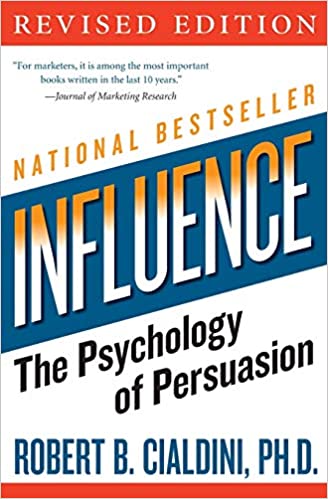Everyone wants to step up to a potential customer, charm them off their feet, and have a sale in the bag within a few minutes, but the reality is more difficult than it looks. However, these upcoming tricks work like magic, and the best thing is, they’re easier than you think!

Influence
by Robert Cialdini
⏱ 14 minutes reading time
🎧 Audio version available
SPIN Selling
SPIN Selling is an extremely lucrative, yet simple, technique. It’s all about asking the right questions, which lead to the right answers. SPIN Selling is actually an acronym. It stands for four types of sales questions that are professionally designed to encourage interest.
SPIN stands for Situation, Problem, Implication, and Need-Payoff. Let’s break each letter down even further.
The first is “Situation.” So, situation questions are the base of a sales pitch. Make sure your questions seek to understand the person in front of you, what their situation is, and whether or not what you’re offering will benefit them.
“Problem” will aid you in this as well. They help your customer become aware of a problem they may have that needs solving– and you being their solver.
Next are the “Implication” questions, which create a sense of urgency in your pitch. Have your questions lead to the negative impact of the problems you just identified.
“Need-Payoff” questions swoop in with a solution. Your prospect just realized the implication of their situation. Need-Payoff questions will help them understand how much of a godsend your offering is.
Mimic Your Prospect
This next technique/skill may seem simpler than the previous tactic, but that doesn’t mean it’s less important– or less efficient. You’re going to come from a psychological angle.
After dealing with a few customers, you may start to notice how they behave. More notably, you may begin to notice how they respond to you.
There’s a science to sales. Experts have found that when you mirror this behavior, mimic the posture of the person you’re trying to sell to, adopting their expressions and gestures, that often increases their perception of you.
This technique started out by being observed in couples who incidentally mirrored each other, but you can find it happening everywhere– at work, in meetings, at networking events, et cetera.
The studies we were speaking about did the following: one observed 60 people, each tasked with negotiating. The ones who mirrored their partner’s body language, expression, manner of speech, and posture reached an agreement 67% of the time. Those who didn’t? They reached an agreement only 12.5% of the time.
Another study studied a total of 100 people. They found that the majority was more inclined to buy more products and have a more positive impression of the company when the salespeople mirrored their behavior.
So, try this method. Before you know it, your customers will be significantly more likely to agree with you.
Practice Active Listening
Active listening is different in sales, yet the entire pitch can depend on it. The purpose of active listening is to build trust with your prospect, a sense of connection that will eventually lead to establishing a customer rapport.
How can you practice active listening? It actually starts when you’re talking. Avoid talking at your customer. When they feel heard and understood, they’re more likely to listen in return.
A few tricks involve non-verbal cues. These include keeping eye contact and nodding when they’re speaking. This, as well as displaying an engaged body language through leaning forward, helps show a sincere interest in what they’re saying.
Mid-conversation, you can offer verbal affirmation– not interruptions– in the form of nodding along and saying things such as, “I see” and “I understand.”
When you apply active listening skills in sales, not only are you able to connect more deeply with your customers, but you’re benefiting your company long-term by deepening your understanding of what your customers are really saying.
Tap Into Their Sense of Fear of Loss
If there is one thing you can rely on in sales, it’s that tapping into a customer’s sense of fear and loss will create an unparalleled urgency. A lot of sales teams forget that their own motivation to make things happen quickly can turn customers off. Everyone has their own timelines and needs. With this trick, you’re approaching the situation by showing them how they’ll be the ones benefiting.
This is why you see so many brands and stores offering limited-time deals. Nothing makes a person rush to purchase something more than fearing of missing out on this amazing deal. The competitive urge, prompted by the sense that someone else will snatch this deal, is naturally hardwired into everyone’s brains.
It’s no wonder professionals use this technique to urge their audience to not just act, but act immediately.
End With an Action
The last technique you can use– literally the last one you use in a meeting is not leaving without setting an action.
For example: at the end of your next meeting, instead of saying “I’ll follow up with you soon,” take action and decide how you’re going to proceed, right here and now.
Another example is when sales teams end meetings by telling their customers they can expect to hear back from them within a few hours or days. Studies found that this results in the next meeting being harder to book. Instead, changing tactics to finishing with an action, such as booking the next meeting on the spot, works wonders.
End your next meeting or pitch with an action. Don’t leave empty-handed. If you can’t set up the next meeting, at least find a way to have a plan that you can both agree on.
What Is Snapreads?

With the Snapreads app, you get the key insights from the best nonfiction books in minutes, not hours or days. Our experts transform these books into quick, memorable, easy-to-understand insights you can read when you have the time or listen to them on the go.


